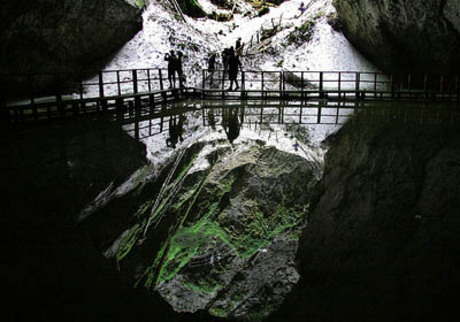Scarisoara Ice cave
Located in a remote place, deep inside the forests of the Apuseni Mountains, Scarisoara is the biggest ice cave in Romania, a unique phenomenon in Southeastern Europe. The exact date when the cave was discovered is unknown, but is mentioned in 1863 by the German geographer Adolf Schmidl, who made some observations and the first map. According to the scientists, Scarisoara Ice Cave was formed during the Ice age, when these mountains were covered by snow and ice.
First mentioned in 1863 by the Austrian geographer Arnold Schmidl, who made some observations and the first map of the cave, it was later explored by the Romanian scientist and speleologist Emil Racoviţă between 1921 and 1923, who mentioned it and its origin in his 1927 work Speleology. According to the scientist Emil Pop, the ice cave was born 3500 years ago, during the glaciations, when these mountains were covered by snow and ice, although the exact date when the cave was discovered is still unknown.
The cave is located at an altitude of 1165 metres above sea level. It is 105 m deep and 720 m long, and the entrance shaft (50 m in diameter and 48 m in depth) gives access through metal stairs to a large chamber, (108 m long, 78 m wide) - The Big Hall. From this point three openings lead to The Church (in front, with over 100 stalagmites), Great Reservation, Coman Gallery (left) and Little Reservation (right). The part that tourists can visit includes the entrance shaft, The Big Hall and The Church, the other chambers, which can be visited only with the agreement of the Speological Institute of Cluj-Napoca, being reserved for scientists.
Scarisoara Cave was formed during The Ice Age when the mountains in which it is nowadays situated were covered with snow and ice. The cave has only one opening in the upper part and so the air currents are formed that keep the ice still solid. In winter, the air temperature in the cave oscillates the same way it does at its entrance; in summer, the temperature reaches up to 1 Celsius degree and that’s why an ice layer in the floor of the Big Hall is melted, but only a few cm.
The glacier has a volume of 75000 cubic metres and it is 26 m high. The temperature is up to +1°C in the summer and down to -7°C in the winter. In the part for tourists the average temperature is around 0°C. Bats live in the ice cave, as do small bugs (2–3 mm long) called Pholeuon prozerpinae glaciale. In the Big Reservation a Rupicapra skeleton was discovered.
It s the biggest ice-cave of Romania. It is at 1165 meter height and it is more that 3000 years old. It has a length of 720 meter and a depth of 105 meter. The volume of the ice we find in the cave is of 75 000 m3 and its width of 15 meter. At its entrance there is a 48 meter deep shaft having a diameter of 60 meter. Actually the cave s entrance is at the bottom of the shaft, the Church is there as well from where a duct of 68 meter takes us to the Big Reservation. In the Cathedral as in the Small Reservation there is no ice but here is for instance the Palace of Sanziana what reach of formation is. The Small reservation is actually at the bottom of a 15 meter high pig. To the big reservation takes an ice-dip of 20 meter and in its continuance a duct. The duct is hardly descends as it gets to the lowest point of the cave: 105 meter deep. This reach in formations, including also ice-feathers duct bears the name of Maxim Pop. Attention! To the cave-visiting definitely take warm clothes.
The glacier entrance (1165m high) is made through an impressive sinkhole, with a diameter of 60m; descending 48 meters, on the bottom of a great abyss, we'll walk over a surface of 70,000 cubic meters of ice, 23 meters thick. Obviously, the glacier temperature is constantly below 0, so in the summer time while descending, there might be a temperature difference of 25 degrees or even more.
The most impressive ice structures are found in the second chamber of the cave - named "The Church", where the ice formations reach over three meters high, with diameters of 15-30 cm.
After climbing back into the daylight, we'll go for a lunch at a local Romanian guesthouse, a few minutes away from the ice cave. The plum brandy ("tzuica") or wild berry brandy ("afinata") will surely be on the table.
The old stories tell that in the cave a dragon used to live in ancient times, which the inhabitants used to call Solomat. The dragon used to steal a beautiful girl, either in the New Years’ Eve or in the night before Girls’ Fare at Gaina and he used to hide them in an ice palace that was never seen by the inhabitants.
Another legend says that, there used to be two water basins that were full of water all the time. They were situated behind the lime formation called nowadays “La Brazi”. It is said that the person that kneeled before the basins, uncovered his/her face, drank the water and made a wish, that wish would come true. The only condition for that to happen was that he/she had the obligation not to tell anyone the wish he/she made.
The visitation is done with the help of a guide after paying an amount of money at the entrance. Groups of 20-50 persons can visit the cave according to this program: 9:00 am, 10:20 am, 11:40 am, 13:00pm, 14:20 pm, 15:40 pm, 17:00 pm.



